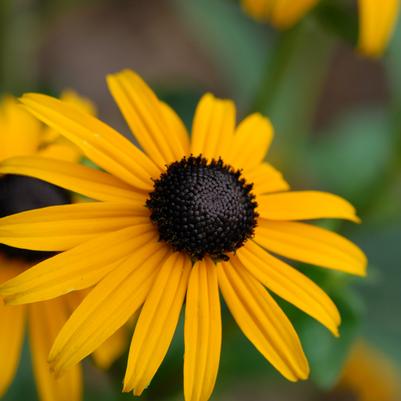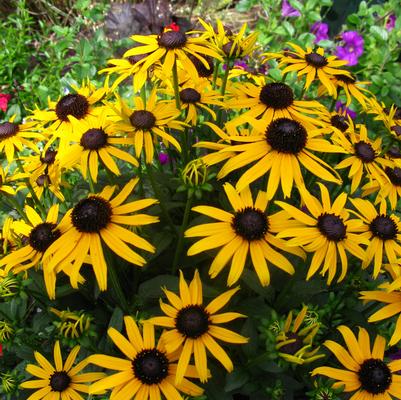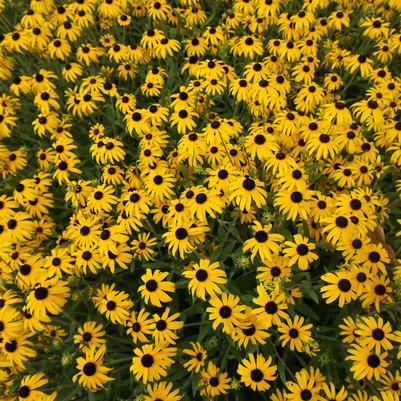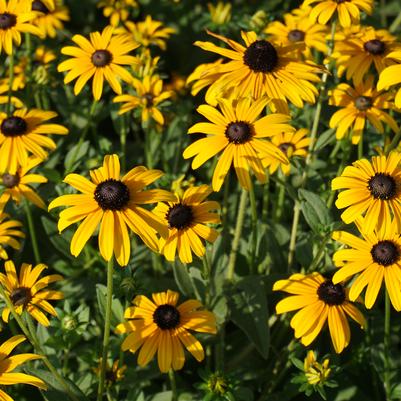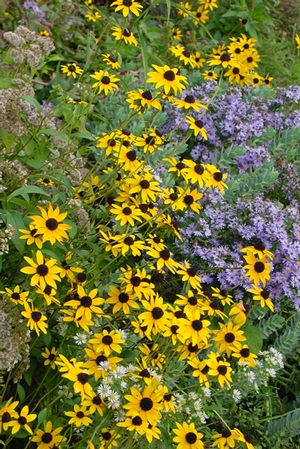





Plant Calculator
Enter the approximate length and width of the area you will be planting and click 'Calculate' to determine how many Rudbeckia fulgida var. fulgida you will need.
Correct and successful spacing is complex and depends on project conditions. We encourage you to call us at 877-ECO-PLUG for project specific recommendations and further assistance.
Rudbeckia fulgida var. fulgida
orange coneflower (black-eyed Susan)
- Category: Perennial, Native
- Hardiness Zone: 5-7
- Height: 24-30 Inches
- Spread: 1-2 Feet
- Spacing: 12-18 Inches
- Bloom Color: Yellow
Shiny, deep green foliage. Smaller and finer than Rudbeckia 'Goldsturm' with 10 weeks of flowers from July into October. Six weeks after 'Goldsturm' is brown, this plant is at its peak! Excellent cut flower. Provides late summer nectar for butterflies and seeds in the winter for birds. Beautiful and versatile!
Click here to download technical information for growers:
Wetland Indicator Status
| • | Falcutative (FAC) |
Propagation Type
| • | Seed cultivar |
Additional Information about Rudbeckia fulgida var. fulgida
Rudbeckia fulgida var fulgida blooms later than most other Rudbeckia which can be the trick when designing a garden. Growing 24-30” and 24 wide, R. fulgida var fulgida has shiny, deep green foliage and which is smaller and finer than Rudbeckia 'Goldsturm' with 10 weeks of flowers from July into October. It even blooms later than variety deamii helping differentiate between the three R. fulgida varieties. Six weeks after 'Goldsturm' is brown, this plant is at its peak! Lovely along a sunny garden path or near a seating area, black-eyed Susan always brings cheer to any location.
Rudbeckia fulgida grows best in dry to medium soil moisture in rich to average soil organic levels in full sun. Traditionally, this widespread native perennial is found from New Jersey to Indiana to Florida to Texas, preferring open woods, meadows, and pastures to roam. It is a trouble-free plant and the dense basal foliage provides an impenetrable herbaceous layer to suppress weeds. When placed in a good location, black-eyed Susan happily self-sows or spreads by creeping rhizomes. Variety fulgida naturally can be found in the eastern United States from New York to Florida to Illinois where it resides in moist woods, meadows, savannas, and swamps. It is adaptable to a wide variety of soil conditions but is most liked for its ability to tolerate hot, humid summers and some drought. For best display, deadhead flowers to prolong blooming season.
Not only is Rudbeckia beautiful en masse, it makes a wonderful and long lasting cut flower (which is a great way to prolong the bloom by deadheading). The coneflowers provide seeds in the winter for birds and nectar for butterflies in the summer. This plant is striking and versatile, outstanding in mass plantings as well as perennial borders, meadows and prairie gardens.
Growing & Maintenance Tips for Rudbeckia fulgida var. fulgida
Grow in full sun and well-drained, average to dry soil moisture. Drought tolerant once established.

